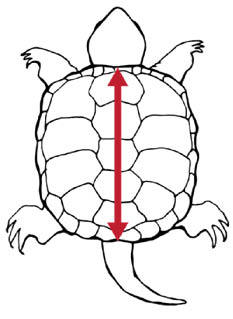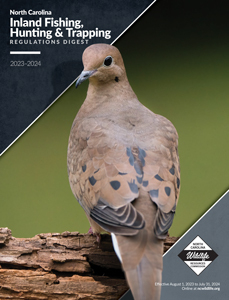Nongame Regulations
General Information
Any animal not classified as a game fish, game animal, furbearer or game bird is considered to be nongame. There are, however, regulations that apply to the taking and collection of these wildlife resources. For animals not specified elsewhere in this Digest, the following guidelines apply:
- Nongame Fish, Crustaceans and Mollusks – See Nongame Fish Regulations for information on collecting nongame fish, crustaceans and mollusks for personal use, sale and bait. A Scientific Fish Collection License is needed to take or collect any aquatic animal for scientific purposes. In addition, a special permit is required when the animal is a freshwater mussel or any endangered, threatened or special concern species.
- Mammals – A Wildlife Collection License is needed to take or collect any nongame mammal. If the animal is endangered, threatened or of special concern, an Endangered Species permit is required.
- Birds – Most birds in North Carolina are defined as migratory and thus are protected by federal laws. Call the U.S. Fish and Wildlife Service for more information at 919-856-4786. The exceptions are the English or House sparrow, pigeon, starling, mute swan, and Eurasian collared dove.
- Reptiles – A Wildlife Collection License is needed to take or collect 5 or more snapping turtles, lizards or snakes on an annual basis. For reptiles that are endangered, threatened or of special concern, an Endangered Species permit is required. Limits for snapping turtles are 10 per day and 100 per year. No snapping turtle less than 13 inches (curved top shell length) may be collected.
- Amphibians – The daily bag limit (from 12:00 noon to 12:00 noon) for taking bullfrogs is 24, with no closed season or license requirement. See General Game Lands Regulations for information and requirements regarding the taking of bullfrogs on game lands. A Wildlife Collection License is needed to take or collect 25 or more frogs (includes toads) or salamanders (includes mudpuppies and “spring lizards”) in larval (tadpole) or adult form. For amphibians that are endangered, threatened or of special concern an Endangered Species permit is required.
Collection Licenses
- Wildlife Collection License and Scientific Fish Collection License applications are available online at ncwildlife.org/licensing/other-licenses-and-permits. For more information about applying, call 833-950-0575.
- The list of endangered, threatened and special concern species in North Carolina is online at ncwildlife.org/conserving
- More information about nongame wildlife or holding animals in captivity is available online at ncwildlife.org/licensing/other-licenses-and-permits or by calling 833-950-0575.
- It is not necessary to obtain a Collection License before defending yourself or another from a wildlife threat.
Restricted Species
It is unlawful to import, transport, export, purchase, possess, sell, transfer, or release into public or private waters or lands of the State, any live specimen(s) of Tongueless or African Clawed Frog (Xenopus spp.), Brown Anole (Anolis sagrei), Cuban Treefrog (Osteopilus septentrionalis), any Asian Newts (genera Cynops, Pachytriton, Paramesotriton, Laotriton, Tylototriton), Red-eared Slider (Trachemys scripta elegans), Greenhouse Frogs, or Argentine Black and White Tegus without first obtaining a Restricted Species Permit.
Measuring a Snapping Turtle
Curved Carapace Length
Measure the length of a snapping turtle along the curvature of the carapace (top shell) with a flexible tape measure that conforms to the snapping turtle’s shell from the nuchal scute (the scute directly behind the turtle’s head) to the base of the notch where the two scutes above the tail meet.


